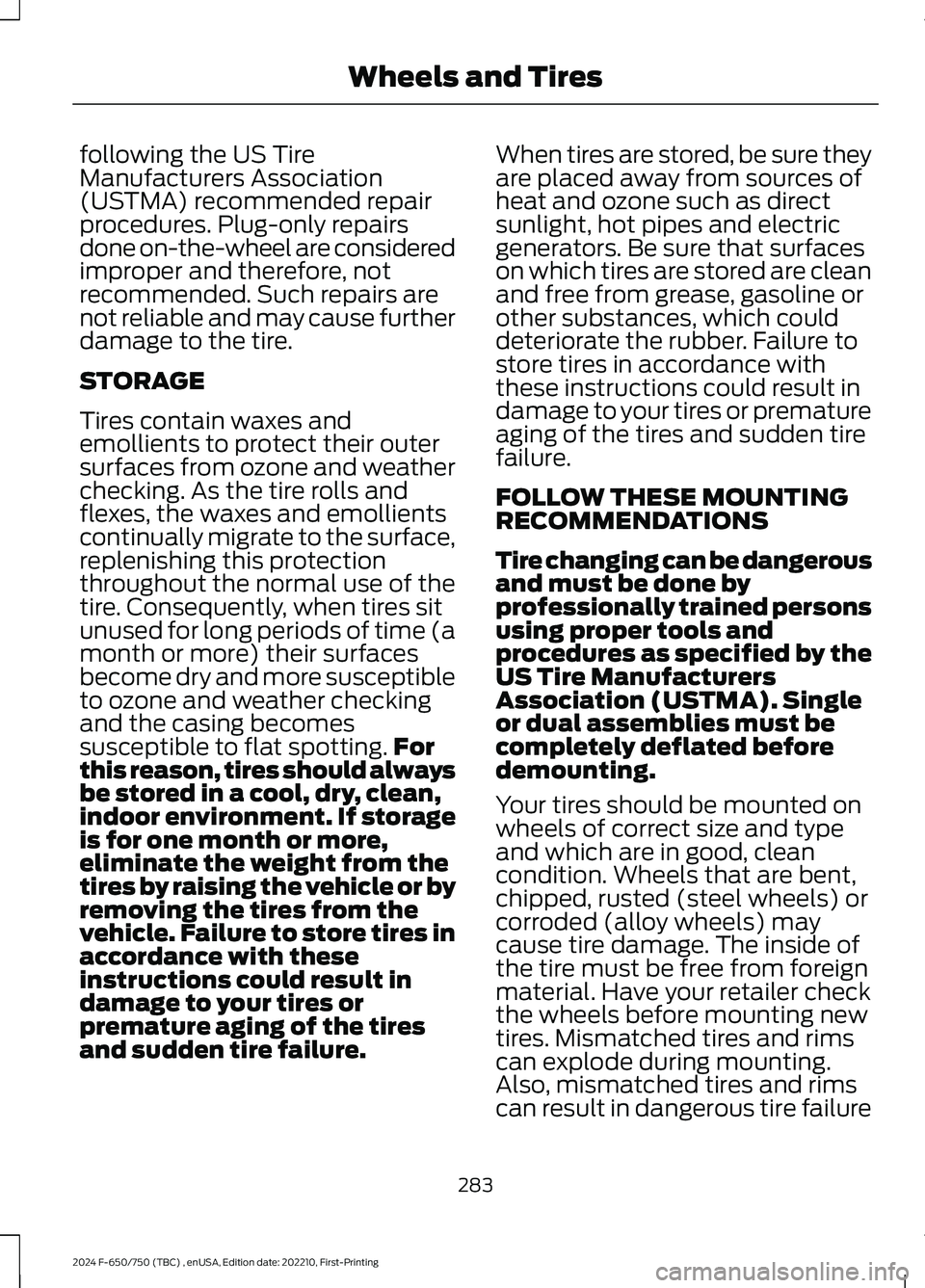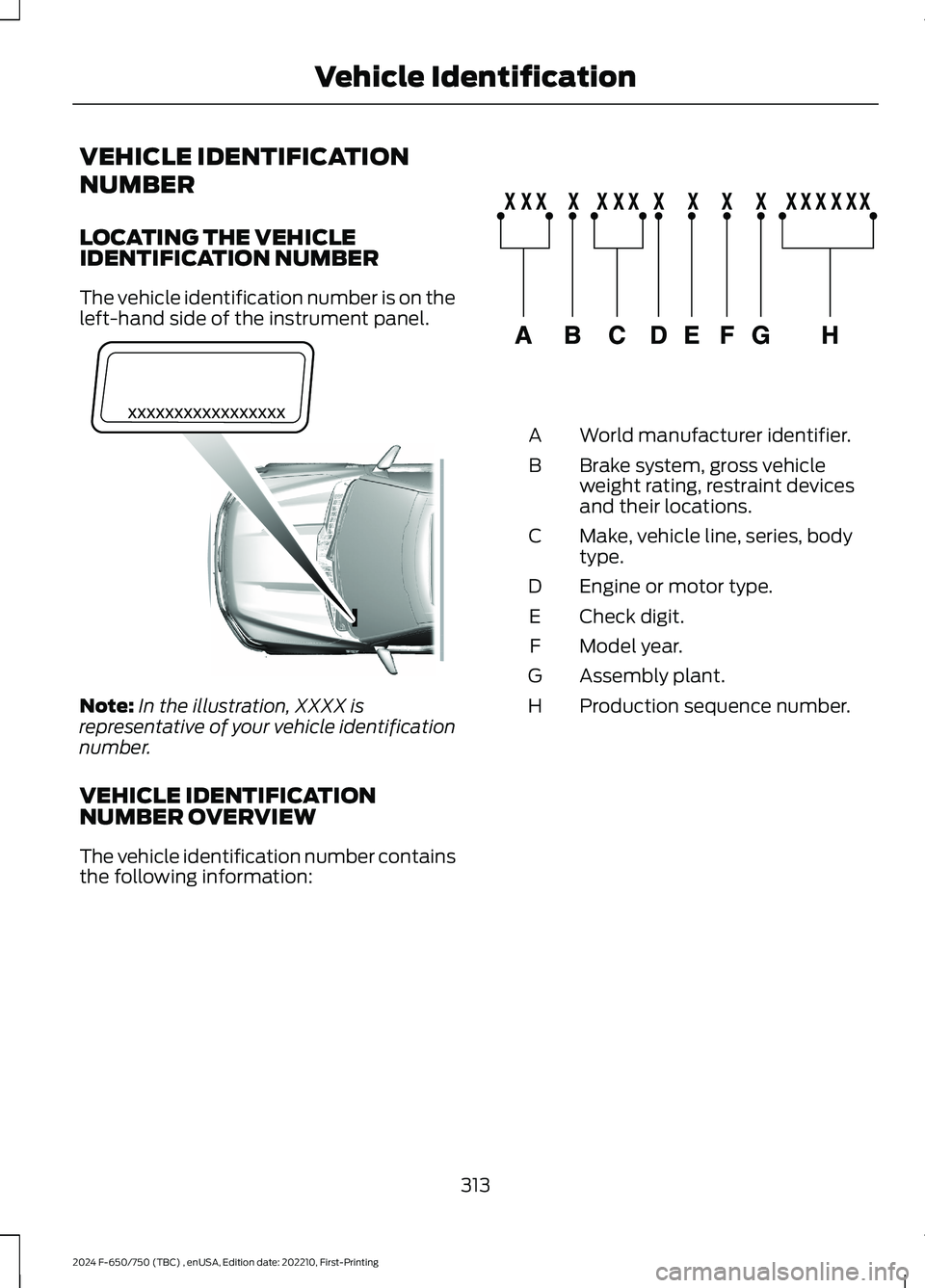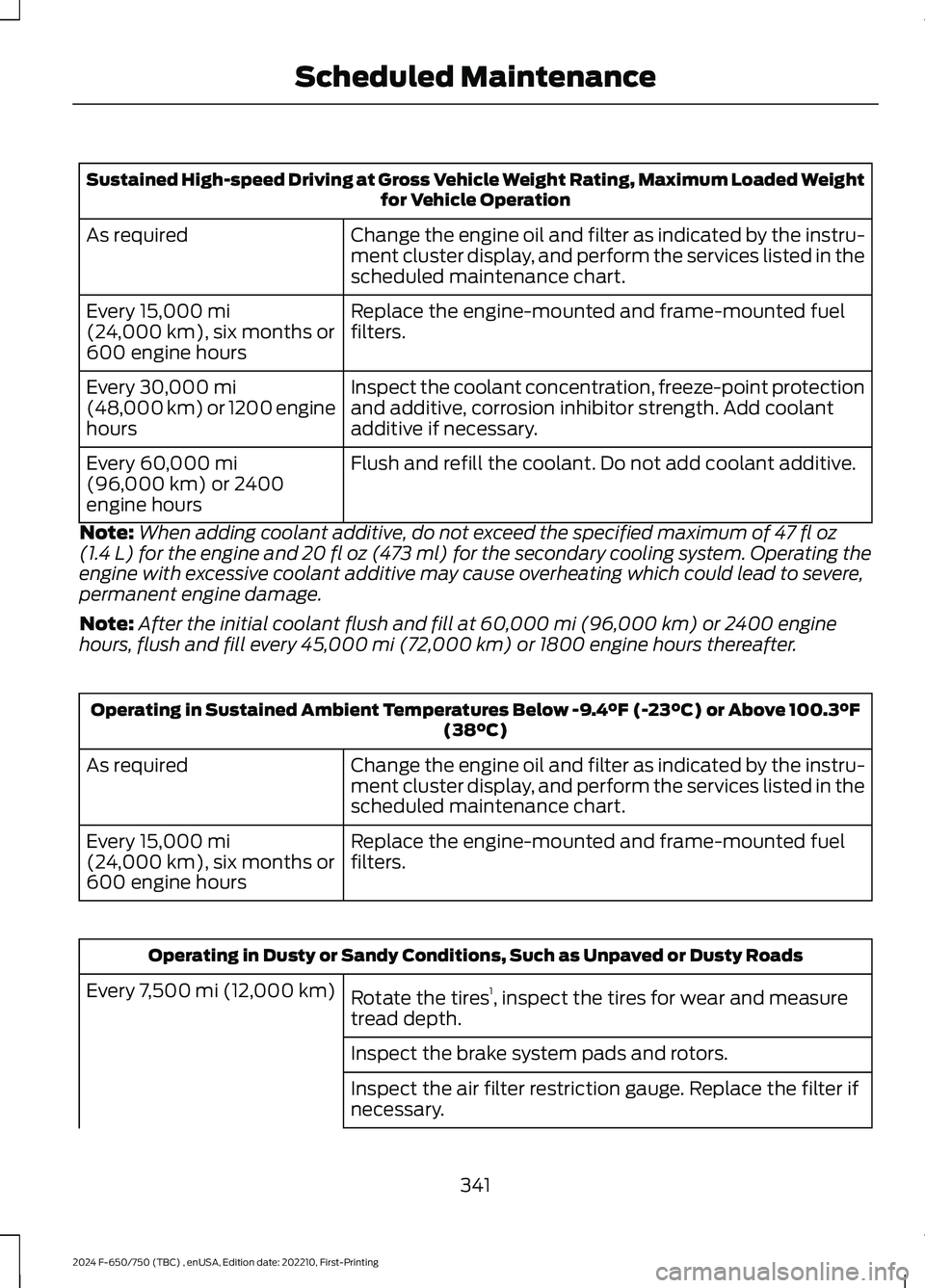2024 FORD F650/750 weight
[x] Cancel search: weightPage 287 of 386

following the US TireManufacturers Association(USTMA) recommended repairprocedures. Plug-only repairsdone on-the-wheel are consideredimproper and therefore, notrecommended. Such repairs arenot reliable and may cause furtherdamage to the tire.
STORAGE
Tires contain waxes andemollients to protect their outersurfaces from ozone and weatherchecking. As the tire rolls andflexes, the waxes and emollientscontinually migrate to the surface,replenishing this protectionthroughout the normal use of thetire. Consequently, when tires situnused for long periods of time (a
month or more) their surfacesbecome dry and more susceptibleto ozone and weather checkingand the casing becomessusceptible to flat spotting.Forthis reason, tires should alwaysbe stored in a cool, dry, clean,indoor environment. If storageis for one month or more,eliminate the weight from thetires by raising the vehicle or byremoving the tires from thevehicle. Failure to store tires inaccordance with theseinstructions could result indamage to your tires orpremature aging of the tiresand sudden tire failure.
When tires are stored, be sure theyare placed away from sources ofheat and ozone such as directsunlight, hot pipes and electricgenerators. Be sure that surfaceson which tires are stored are cleanand free from grease, gasoline orother substances, which coulddeteriorate the rubber. Failure tostore tires in accordance withthese instructions could result indamage to your tires or prematureaging of the tires and sudden tirefailure.
FOLLOW THESE MOUNTINGRECOMMENDATIONS
Tire changing can be dangerousand must be done byprofessionally trained personsusing proper tools and
procedures as specified by theUS Tire ManufacturersAssociation (USTMA). Singleor dual assemblies must becompletely deflated beforedemounting.
Your tires should be mounted onwheels of correct size and typeand which are in good, cleancondition. Wheels that are bent,chipped, rusted (steel wheels) orcorroded (alloy wheels) maycause tire damage. The inside ofthe tire must be free from foreignmaterial. Have your retailer checkthe wheels before mounting newtires. Mismatched tires and rimscan explode during mounting.Also, mismatched tires and rimscan result in dangerous tire failure
283
2024 F-650/750 (TBC) , enUSA, Edition date: 202210, First-PrintingWheels and Tires
Page 317 of 386

VEHICLE IDENTIFICATION
NUMBER
LOCATING THE VEHICLEIDENTIFICATION NUMBER
The vehicle identification number is on theleft-hand side of the instrument panel.
Note:In the illustration, XXXX isrepresentative of your vehicle identificationnumber.
VEHICLE IDENTIFICATIONNUMBER OVERVIEW
The vehicle identification number containsthe following information:
World manufacturer identifier.A
Brake system, gross vehicleweight rating, restraint devicesand their locations.
B
Make, vehicle line, series, bodytype.C
Engine or motor type.D
Check digit.E
Model year.F
Assembly plant.G
Production sequence number.H
313
2024 F-650/750 (TBC) , enUSA, Edition date: 202210, First-PrintingVehicle IdentificationE311767 E142477
Page 325 of 386

AUXILIARY SWITCHES (IF
EQUIPPED)
For maximum vehicle performance, keepthe following information in mind whenadding accessories or equipment to yourvehicle:
•When adding accessories, equipment,passengers and luggage to yourvehicle, do not exceed the total weightcapacity of the vehicle or of the frontor rear axle (GVWR or GAWR asindicated on the Safety ComplianceCertification label). Ask an authorizeddealer for specific weight information.
•The Federal CommunicationsCommission (FCC) and CanadianRadio TelecommunicationsCommission (CRTC) regulate the useof mobile communications systemsequipped with radio transmitters, forexample, two-way radios, telephonesand theft alarms. Any such equipmentinstalled in your vehicle should complywith Federal CommunicationsCommission (FCC) and CanadianRadio TelecommunicationsCommission (CRTC) regulations, andshould be installed by an authorizeddealer.
•An authorized dealer needs to installmobile communications systems.Improper installation may harm theoperation of your vehicle, particularlyif the manufacturer did not design themobile communication systemspecifically for automotive use.
•If you or an authorized Ford dealer addany non-Ford electrical or electronicaccessories or components to yourvehicle, you may adversely affectbattery performance and durability. Inaddition, you may also adversely affectthe performance of other electricalsystems in the vehicle.
The auxiliary switch option packageprovides four switches, mounted in thecenter of the instrument panel. Theseswitches operate when the ignition is onor from battery power, depending on theswitchable power distribution box fuselocations #82 and #83. We recommend,however, that the engine remain runningto maintain battery charge when using theauxiliary switches for extended periods oftime or higher current draws.
Note:When your vehicle has a dieselengine, use the auxiliary switches only whilethe engine is running. The glow plugs alsodrain battery power when the ignition key isin the on position. Using the auxiliaryswitches, even for limited amounts of time,can cause your battery to drain quickly andprevent your vehicle from restarting.
When switched on, the auxiliary switchesprovide 20 amps or 40 amps of electricalbattery power for a variety of personal orcommercial uses.
The relays for the auxiliary switches are inthe power distribution box under the hoodby the right-hand fender. See yourauthorized dealer for service.
Each switch includes a power lead, ablunt-cut and sealed wire below theinstrument panel and to the left of thesteering column in the driver footwell area.
The power leads are coded as shown:
321
2024 F-650/750 (TBC) , enUSA, Edition date: 202210, First-PrintingAccessoriesE163431
Page 345 of 386

Sustained High-speed Driving at Gross Vehicle Weight Rating, Maximum Loaded Weightfor Vehicle Operation
Change the engine oil and filter as indicated by the instru-ment cluster display, and perform the services listed in thescheduled maintenance chart.
As required
Replace the engine-mounted and frame-mounted fuelfilters.Every 15,000 mi(24,000 km), six months or600 engine hours
Inspect the coolant concentration, freeze-point protectionand additive, corrosion inhibitor strength. Add coolantadditive if necessary.
Every 30,000 mi(48,000 km) or 1200 enginehours
Flush and refill the coolant. Do not add coolant additive.Every 60,000 mi(96,000 km) or 2400engine hours
Note:When adding coolant additive, do not exceed the specified maximum of 47 fl oz(1.4 L) for the engine and 20 fl oz (473 ml) for the secondary cooling system. Operating theengine with excessive coolant additive may cause overheating which could lead to severe,permanent engine damage.
Note:After the initial coolant flush and fill at 60,000 mi (96,000 km) or 2400 enginehours, flush and fill every 45,000 mi (72,000 km) or 1800 engine hours thereafter.
Operating in Sustained Ambient Temperatures Below -9.4°F (-23°C) or Above 100.3°F(38°C)
Change the engine oil and filter as indicated by the instru-ment cluster display, and perform the services listed in thescheduled maintenance chart.
As required
Replace the engine-mounted and frame-mounted fuelfilters.Every 15,000 mi(24,000 km), six months or600 engine hours
Operating in Dusty or Sandy Conditions, Such as Unpaved or Dusty Roads
Rotate the tires1, inspect the tires for wear and measuretread depth.
Every 7,500 mi (12,000 km)
Inspect the brake system pads and rotors.
Inspect the air filter restriction gauge. Replace the filter ifnecessary.
341
2024 F-650/750 (TBC) , enUSA, Edition date: 202210, First-PrintingScheduled Maintenance
Page 385 of 386

R
Radio Frequency CertificationLabels............................................................345Cruise Control Module.....................................345Rear Axle Fluid Capacity andSpecification - Diesel..............................309Rear Axle Fluid Capacity andSpecification - Gasoline...........................311Rear Axle Fluid Check................................260Rear Axle..........................................................136General Information..........................................136Rear Seat Armrest.........................................95Rear Seats........................................................94Rear View Camera........................................157Rear View CameraSee: Rear View Camera....................................157Recommended Towing Weights............182Refueling - Diesel...........................................112Refueling - Gasoline.....................................114Remote Control...............................................47Removing a Headlamp.............................250Repairing Minor Paint Damage..............266Replacement PartsRecommendation........................................15Replacing a Lost Key or RemoteControl............................................................48Reporting Safety Defects (CanadaOnly)...............................................................201Reporting Safety Defects (U.S.Only).............................................................200Resuming the Set Speed...........................159Roadside Assistance...................................194Roadside Emergencies..............................190Rollover Warning.........................................345Running-InSee: Breaking-In..................................................188Running Out of Fuel - Diesel......................112Running Out of Fuel - Gasoline................112
S
Safety Precautions.......................................107Scheduled Maintenance...........................325Seatbelt Extensions......................................45Seatbelt Height Adjustment......................42Seatbelt Reminder........................................43
Seatbelts...........................................................38Principle of Operation........................................38Seatbelt Warning Lamp and IndicatorChime..............................................................43Seats...................................................................89Security...............................................................51Selective Catalytic Reductant System -Diesel.............................................................120Setting the Cruise Control Speed..........158Sitting in the Correct Position...................89Snow ChainsSee: Using Snow Chains.................................287Spare WheelSee: Changing a Road Wheel........................287Special Notices................................................16Special Operating Conditions ScheduledMaintenance...............................................335Speed ControlSee: Cruise Control............................................158Spring U-Bolt Check....................................261Stability Control............................................153Principle of Operation - Vehicles With: AirBrakes................................................................154Principle of Operation - Vehicles With:Hydraulic Brakes............................................153Starter SwitchSee: Ignition Switch............................................101Starting a Diesel Engine.............................103Starting a Gasoline Engine.......................102Starting and Stopping the Engine..........101General Information...........................................101Steering............................................................170Steering System Inspection....................259Steering Wheel................................................52Storage Compartments............................100Streaming Bluetooth Audio......................318Sun Visors.........................................................63Suspension System Inspection.............260Switching Cruise Control On andOff...................................................................158Switching Off the Engine..........................104Switching the Pneumatic LockingDifferential On and Off............................137Symbols Glossary...........................................19Symbols Used on Your Vehicle..................19
381
2024 F-650/750 (TBC) , enUSA, Edition date: 202210, First-PrintingIndex